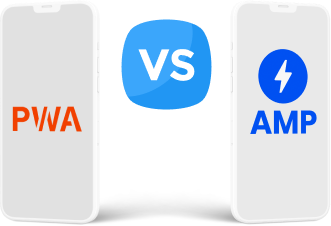PWA Vs AMP
In this day and age, almost everyone owns a smartphone. Take a look around a train station or a bus, and you will see people chatting or scrolling through a website or an app to keep them busy. From a business perspective, the popularity of smartphones can bring a business endless benefits and opportunities – the opportunities to grow bigger and stronger. Therefore, making a business go mobile seems the right move to achieve more success, especially for online companies. However, it does not necessarily mean they need to go for a native app. There are tons of options out there, and PWA vs AMP are two of the best solutions. Let’s dive into this post to see which is the right solution for online businesses.
Contents
What Is PWA?

PWA (short for Progressive Web App) is basically a website designed to look, act and operate the way a native app does. With the “Add To Home Screen” feature, users can install the web app on their device and use it as a regular app.
PWA’s Key Features
PWAs are especially useful for these features and characteristics:
Add to home screen
PWA’s “add to home screen” function makes it really easy for users to install PWA on their devices.
All they need to do is to visit the site integrated with PWA, tap the “add to home screen” button, and it will appear on their devices in just a few seconds.
Fast speed
PWA allows mobile users to load the site faster and have a better experience exploring the site.
The fast delivering journey that PWA offers customers really matters because speed plays an important role in customers’ decision whether they should buy something from a website or not.
Offline mode
The ability to work in offline or bad networks makes PWA much more convenient than a normal website. It works because of the automatically saved data of users’ last visit to the site.
More specifically, important content such as order history, shopping carts, the home page, etc., can be seen when there is no internet connection. They will be refreshed every time the connection is back. However, if users want to send a message, it will require an internet connection.
Push notifications
Push notifications are an important tool to help retailers attract users’ attention by sending updates. A special thing about PWA’s ability to send push notifications is that the users can receive them even when the app is closed.
App-like interface
Nowadays, mobiles tend to choose to use an app over a browser because an app is more user-friendly and has a more attractive interface.
Full-screen option
With PWA, users can get rid of the menu bar and the URL bar at the top and bottom of the device’s screens. PWA is also compatible with any screen size and width.
SEO friendly
PWA helps merchants with SEO by making the user experience on the app better than normal websites. Besides, PWA is super fast and mobile-friendly, which are all important factors in getting higher rankings for the site and getting more organic traffic.
Read More: Do Progressive Web Apps Improve SEO?
Automatic update
PWA has a special capability to update itself automatically without bothering users to give permissions. Every time users open their apps, these PWAs will update themselves and provide a fresh look.
More Security
Security when shopping online is no longer a concern, thanks to PWA. PWA only serves through a secured portal like HTTPS servers, which can prevent unwanted man-in-the-middle attacks.
What Is AMP?

AMP (short for Accelerated Mobile Page) is a mobile-friendly web page designed to create faster loading web pages for mobile users.
Fast loading speed is one of the essential requirements of any website because it helps enhance the user experience and reduce the bounce rate.
AMP’s Key Features
High page loading speed
AMP is created especially to reduce the loading time of the page. The fast page loading speed will also increase the likelihood that customers will stay on the site for longer and lower the bounce rates.
All formats of ads support
Although AMP is suitable for lightweight content, it does support all kinds and formats of ads.
Search ranking improvement
AMP focuses on lightweight content, which can improve the browsing experience when navigating through the site. In addition, AMP also decreases page loading time, improving the chance that visitors will stay on-site for a longer amount of time.
Besides, since AMP is developed by Google, it is given priority in search algorithms. This has a positive effect on the search engine results pages and increases the site’s rank.
Content heavy websites suitability
AMP not only is huge compatibility for heavy content-based websites but also it will be shown as the preview of the “Top Stories” above the other results for a specific topic.
This will make the site’s content visible and stand out on the front page of Google, which content-based websites benefit a lot from.
PWA Vs AMP: How Are They Similar?
Both PWA and AMP are great solutions to display web pages on mobile devices. They both are created to better the user experience and reduce page loading time.
Although AMP is slightly better at decreasing loading time than PWA, the difference in loading speed between PWA and AMP is barely noticeable.
PWA Vs AMP: How Are They Different?
Despite the similarity between PWA and AMP, there are quite a lot of differences between them:
1. Main Uses
PWA: works perfectly for almost all kinds of businesses, especially e-commerce and social media businesses, where user interactions are an important requirement.
AMP: is more suitable for media companies, blog sites, and companies with platforms with walls of content. Although AMP is able to show content instantly, it lacks interaction opportunities.
2. Development
PWA: is coded mostly with Javascript.
AMP: is stripped down unnecessary CSS and Javascript to offer faster web page load.
3. Appearance
PWA: allows you to feel like using a native app without even realizing that you are using a website.
AMP: looks just like a normal web page with an irreducible design.
4. Accessibility
PWA: Thanks to its offline mode, it can load without an internet connection or in poor internet network condition. Besides, users can access it directly in the devices’ home menu.
AMP: needs an internet connection all the time and only opens in the web browser, not in the phone’s home menu.
5. User Experience
PWA: provides a much better user experience with many app-like features such as push notifications, a home screen icon, and so on. Besides, it is so easy to download a PWA since it is light in size and has the “add-to-home-screen” function.
AMP: slightly improves the user experience because of faster page loads. Since AMP only focuses on reducing the page loading time.
6. Speed
PWA: When you first visit the website, PWAs take longer than AMPs to load. However, both PWAs and AMPs will load equally fast when users revisit the site.
AMP: When it comes to loading page speed, AMP is the winner since it only supports lightweight content.
7. Support
PWA: is not supported equally on all devices. For iOS device users, they may find a few inconveniences since Apple hasn’t fully supported PWA yet. However, Apple is working on the improvement of PWA on iOS devices.
AMP: is supported completely by main browsers on all devices.
8. Discoverability
PWA: Since PWAs focus on improving user experience and are SEO – friendly, they do a great job decreasing bounce rate and increasing the duration of sessions.
AMP: With the help of a carousel in Google search results, AMP definitely wins this battle.
9. Interactivity
PWA: has the most amazing interactivity functionality, some of which are only expected on a native mobile app. These involve features such as push notifications and a home screen app icon.
AMP: does not offer different interactivity options like PWA.
10. Engagement
PWA: can contain far more interesting and diverse content than AMP. Since PWA offers much more options like push notifications and sharing, it attracts higher engagement.
AMP: Because the page only gets loaded in the browser, it attracts lower engagement.
PWA Vs AMP Vs Native App & Website – Which One Is Better?

Although many people use apps today, having an app for your online business is not enough. Apps cannot replace webs completely, making it necessary for companies to develop a mobile-friendly web page.
Both PWA and AMP can serve this objective efficiently. In order to find out which one is better than a native app and a website, let’s continue to read.
Why Is PWA Better Than A Website?
All the problems of browser tabs, slow loading speed, slow network connection, small screen, and annoying pop-ups can be solved by Progressive Web App.
PWA helps users install the app to their devices in just a few seconds. You may think that a native app has all of these benefits, but the actual answer is not. Let’s figure out why PWA is better than a native app.
Why Is PWA Better Than A Native Mobile App?
If you want to use a native app, the first step you need to take is to go to the market store to download it. Then, you will have to wait for its download process to complete.
If you don’t have enough free space on your device, you will have to delete some data to have room for your new app.
With PWA, all of these problems are perfectly solved. You can install PWA in just a few seconds and use it right away.
Besides, it takes up only a little data on your phone, so you don’t need to delete any existing files or apps on your devices. To learn more about the comparison between PWA and a native app, check out this post.
Why IS AMP Better Than A Website?
A traditional website has some loading time problems and inconvenience for users, but AMP helps solve these problems. AMP can both increase the page loading speed and use much less data than a regular website.
Why Is AMP Not Better Than A Native Mobile App?
In spite of the benefits AMP brings to the table, it cannot replace a native app. Users cannot install AMP into their home screen.
Moreover, AMP still contains browser tabs, which is quite inconvenient for users. In addition, AMP’s functionality is limited to just basic options since it is suitable for content-based websites only.
Can We Use PWA And AMP Together?

Online businesses can choose AMP solely to bring a fast but simple user experience to users. Or they can pick PWA to improve user experience but have slower first-page loading.
However, business owners can start fast and stay fast by integrating both AMP and PWA into their websites.
Therefore, the answer is yes. You can use PWA and AMP together to offer a much more elegant user experience.
With the combination of PWA and AMP, users can:
- Experience an app-like website
- Allow push notifications to remind them of important deals
- Use the app when there is no internet connection
- Navigate smoothly through the website
Although combining them would bring much more benefits, its development is the main challenge. Firms should find experts to help with the integrations.
So, PWA Vs AMP: Which Wins?
After making a detailed comparison of “PWA Vs AMP”, it’s clear that both PWA and AMP are powerful solutions to mobile web apps and are used for different goals.
Are you finding the solution to a mobile web app with app-like features? PWA is what you should go for.
Looking for a solution to a content-based web app? Try AMP.
Though both PWA and AMP bring certain benefits to a business, PWA still slightly wins this battle when it comes to overall benefits.
